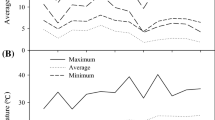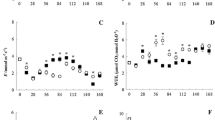Abstract
We studied the effects of light quality and defoliation on the rate of phytomer appearance and axillary bud outgrowth in white clover. The treatments were applied to one phytomer, a phytomer being defined as the structural unit comprising a node, internode, axillary bud, subtending leaf and two nodal root primordia. Light of a low red:far-red (R:FR) ratio (0.27) was applied to a “target” phytomer either (i) within the apical bud and then to the axillary bud after emergence of the phytomer from the apical bud, or (ii) to the axillary bud only after emergence. The light conditions were directed to these specific parts of the plant by collimating light from small FR light-emitting diodes; with this technique we were able to change the light quality without any change in the level of photosynthetically active radiation. The subtending leaf of the target phytomer was retained or defoliated when it had emerged from the apical bud. FR light applied from the time the phytomer was within the apical bud caused a delay in branch appearance at the target phytomer. In contrast, direct treatment of the axillary bud with FR light after it had emerged from the apical bud did not result in any delay in branch appearance. As the light treatment of the apical bud may have changed the light environment of any of the organs contained in the bud we were unable to ascribe the delay in branch appearance to light perception by any particular organ. However, indirect evidence leads to the conclusion that the likely site of light perception was the developing leaf subtending the axillary bud while it was the outermost phytomer within the apical bud. These results do not support the hypothesis that the R:FR ratio of light incident at an axillary bud site is the environmental factor that controls bud development. Defoliation of the unfolding leaf reduced the rate of phytomer appearance on the main stolon but had no immediate effect on branch appearance. As a consequence there was a reduction in the number of phytomers between the stolon apical meristem and the first phytomer with a branch. This is frequently taken to indicate a relaxation of apical dominance, but in this case was found not to involve a direct effect on bud activity. A current model of white clover growth suggests that there is integration of activity between apical meristems but independence of activity and response to the local micro-environment by axillary buds. In contrast, we found that (i) defoliation reduced phytomer appearance only at the main stolon apical meristem and not at all the meristems in the plant and (ii) that a change in the local light environment of an axillary bud had no discernible effect on bud activity once the bud had emerged from the apical bud but could delay branching if applied before emergence. These results are at variance with the predictions of the model.
Similar content being viewed by others
References
Carlson GE (1966a) Growth of clover leaves. Developmental morphology and parameters at ten stages. Crop Sci 6:293–294
Carlson GE (1966b) Growth of clover leaves after complete or partial leaf removal. Crop Sci 6:419–422
Casal JJ, Deregibus VA, Sánchez RA (1985) Variations in tiller dynamics and morphology in Lolium multiflorum Lam. vegetative and reproductive plants as affected by differences in red/far-red radiation. Ann Bot 56:59–65
Deregibus VA, Sánchez RA, Casal JJ (1983) Effects of light quality on tiller production in Lolium spp. Plant Physiol 72:900–902
Deregibus VA, Sánchez RA, Casal JJ, Trlica MJ (1985) Tillering responses to enrichment of red light beneath the canopy in a humid natural grassland. J Appl Ecol 221:199–206
Grant SA, Barthram GT (1991) The effects of contrasting cutting regimes on the components of clover and grass growth in microswards. Grass Forage Sci 46:1–13
Grant SA, Torvell L, Sim EM, Small J (1991) The effect of stolon burial and defoliation early in the growing season on white clover performance. Grass Forage Sci 46:173–182
Harris W (1987) Population dynamics and competition. In: Baker MJ, Williams WM (eds) White clover. CAB International Wallingford, pp 203–297
Holmes MG, Smith H (1975) The function of phytochrome in plants growing in the natural environment. Nature 254:512–514
Hutchings MJ, Mogie M (1990) The spatial structure of clonal plants: control and consequences. In: Van Groenendael J Kroon H de (eds) Clonal growth in plants: regulation and function. SPB Academic, The Hague, pp 57–76
King J, Lamb WIC, McGregor MT (1978) Effect of partial and complete defoliation on regrowth of white clover plants. J Br Grass Soc 33:49–55
McCree K (1971) The action spectrum, absorptance and quantum yield of photosynthesis in crop plants. Agric Meteorol 9:191–216
Moulia B, Varlet-Grancher C, Jacques R (1989) Phytochrome control of white clover morphogenesis. Description and ecological significantion. Plant Physiol Life Sci Adv 8:105–111
Murphy JS, Birske DD (1994) Density-dependent regulation of ramet recruitment by the red:far-red ratio of solar radiation: a field evaluation with the bunchgrass Schizachyrium scoparium. Oecologia 97:462–469
Robin Ch, Varlet-Grancher C, Gastal F, Flenet F, Guckert A (1992) Photomorphogenesis of white clover (Trifolium repens L.): phytochrome mediated effects on 14C-assimilate partitioning. Eur J Agron 1:235–240
Robin Ch, Hay MJM, Newton PCD, Greer DH (1994) Effect of light quality (red:far-red ratio) at the apical bud of the main stolon on morphogenesis of Trifolium repens L. Ann Bot 74:119–123
Solangaarachchi SM, Harper JL (1987) The effect of canopy filtered light on the growth of white clover Trifolium repens. Oecologia 72:372–376
Thomas RG (1987) Vegetative growth and development. In: Baker MJ, Williams WM (eds) White clover. CAB International, Wallingford, pp 31–62
Thomspon L (1993) The influence of the radiation environment around the node on morphogenesis and growth of white clover (Trifolium repens). Grass Forage Sci 48:271–278
Thompson L, Harper JL (1988) The effect of grasses on the quality of transmitted radiation and its influence on the growth of white clover Trifolium repens. Oecologia 75:343–347
Turkington R, Sackville Hamilton R, Gliddon C (1991) Withinpopulation variation in localised and integrated response of Trifolium repens to biotically patchy environments. Oecologia 86:183–192
Varlet-Grancher C, Moulia B, Jacques R (1989) Phytochrome mediated effects on white clover morphogenesis. In: Desroches R, Association Française pour la production fourragire. INRA Versailles, France (ed). Proceedings 16th Intl Grassl Congress, Nice, France, 477–478
Winer BJ (1971) Statistical principles in experimental design, 2nd ed. McGraw Hill, New York
Author information
Authors and Affiliations
Rights and permissions
About this article
Cite this article
Robin, C., Hay, M.J.M. & Newton, P.C.D. Effect of light quality (red: far-red ratio) and defoliation treatments applied at a single phytomer on axillary bud outgrowth in Trifolium repens L.. Oecologia 100, 236–242 (1994). https://doi.org/10.1007/BF00316950
Received:
Accepted:
Issue Date:
DOI: https://doi.org/10.1007/BF00316950




